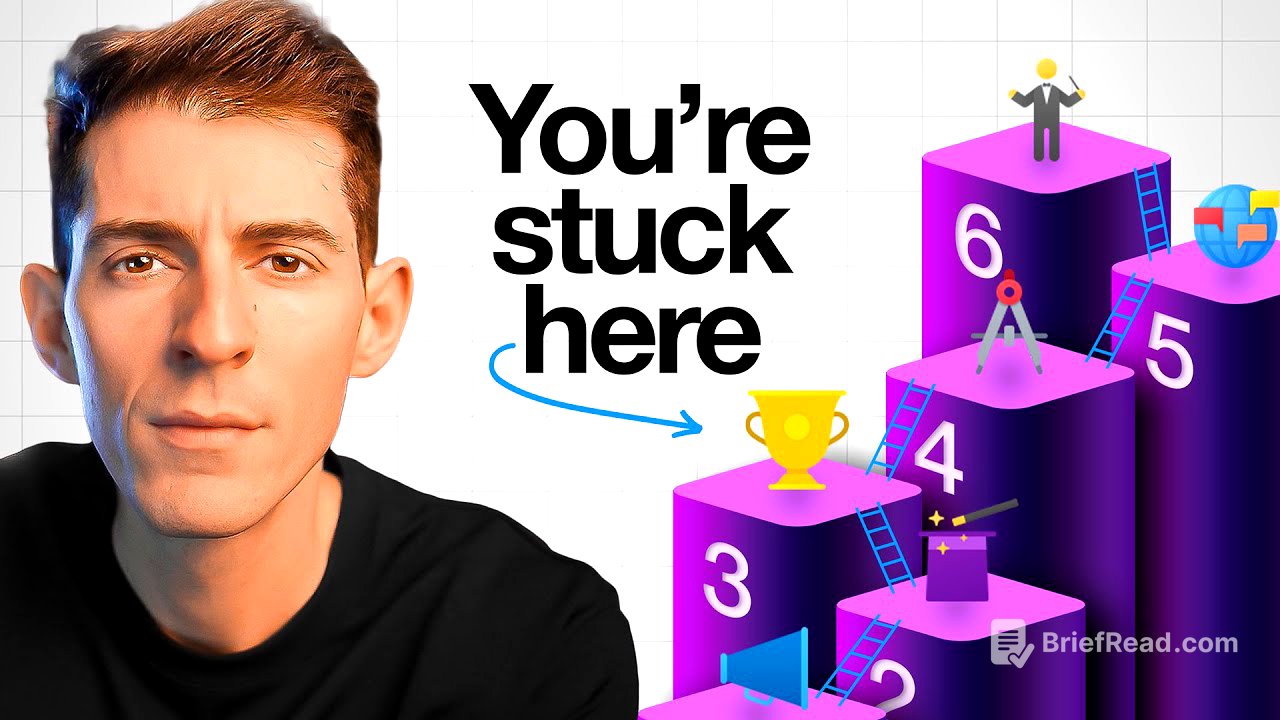TLDR;
This video outlines a six-level framework, the "Story Ladder", for improving storytelling skills. It emphasises moving beyond simply reporting facts (Level 1) to incorporating hooks (Level 2), establishing stakes (Level 3), using arcs and loops (Level 4), ensuring comprehension (Level 5), and finally, injecting your unique style (Level 6). Mastering these levels can significantly improve audience engagement and help achieve business goals.
- Level 1: The Reporter - Focuses on facts without engaging the audience.
- Level 2: The Illusionist - Introduces hooks and misdirection to create intrigue.
- Level 3: The Champion - Establishes stakes and relevance for the viewer.
- Level 4: The Architect - Uses arcs and loops to add layers and navigation to the story.
- Level 5: The Translator - Ensures comprehension through visuals and metaphors.
- Level 6: The Maestro - Adds a unique signature style to make the story stand out.
Intro [0:00]
The video introduces the concept of a "story ladder" with six levels of storytelling mastery. Climbing this ladder leads to better stories and greater success. Most people are stuck on the lower levels, struggling to hold audience attention. However, with a few adjustments, anyone can learn to climb the ladder and become a master storyteller. Achieving level six consistently will lead to business success.
Level 1 [0:46]
Level one storytelling is called "The Reporter," the foundational level where most people start. It involves simply stating facts in order, much like a news report. This approach is unengaging because it lacks elements that drive curiosity and contrast. Great stories hold attention by creating twists and turns, keeping the brain off balance. Level one storytelling involves gathering the basic elements of a story (who, what, when, where) and presenting them in a predictable order, leading to viewer boredom. The key is to climb at least one more level to have a chance at holding attention.
Level 2 [3:08]
Level two storytelling introduces hooks, which are not just initial attention-grabbers but also elements embedded throughout the story ("rehooks"). The storyteller at this level is called "The Illusionist" because hooks are essentially misdirection. They create contrast between what the brain expects and what is revealed, which is the secret to engaging hooks. By setting up an expectation and then subverting it, you create intrigue and keep the viewer guessing. Including a misdirection every 2-3 minutes is a powerful way to maintain attention. Level two involves adding these hooks to the foundational elements of the story.
Level 3 [7:16]
Level three storytelling builds upon the foundations and hooks by adding a reason for the viewer to care, establishing stakes. The storyteller at this level is called "The Champion" because the story champions a specific use case, pain point, or individual archetype. While levels one and two provide the psychological building blocks, level three aims the story directly at the viewer, making it personally relevant. This can be achieved by directly addressing a pain point the viewer experiences or, in entertainment, by creating relatable characters and conflicts that the viewer can see themselves in.
Level 4 [9:49]
Level four storytelling incorporates arcs and loops, adding layers and navigation to the story. The storyteller at this level is called "The Architect". Arcs involve building and releasing tension, creating a wave-like pattern. Modern stories often use multiple, faster arcs centred around different hooks. In educational content, loops are used instead of arcs. Loops are self-contained and repeatable patterns. A minor loop includes what is going on, why it matters, an example, and tactical recommendations. Using loops makes it easier for the viewer to orient themselves within the story, improving story navigation.
Level 5 [12:21]
Level five storytelling focuses on resonance, ensuring the story is easily understood. The storyteller at this level is called "The Translator". Stories are only as good as the comprehension they drive. This level involves reviewing the story to ensure every line hits as intended. Tactics to improve comprehension include using on-target visuals and adding secondary metaphors to explain complex concepts in simpler terms. The key is to anticipate potential points of confusion for a novice viewer and address them proactively.
Level 6 [14:25]
Level six storytelling is about adding a signature style and unique fingerprint to the story. The storyteller at this level is called "The Maestro". While the first five levels focus on mastering the base components, this final level is about making the story uniquely yours. Signature style is the one thing you can do that no one else can. It takes time and practice to develop. The recommendation is to focus on mastering the first five levels, and your signature style will emerge over time.
Outro [16:06]
The video concludes by recommending beginners start with level one and gradually build up, adding one piece at a time. The presenter also promotes additional resources and a tool called sandcastles.ai to help with storytelling.









